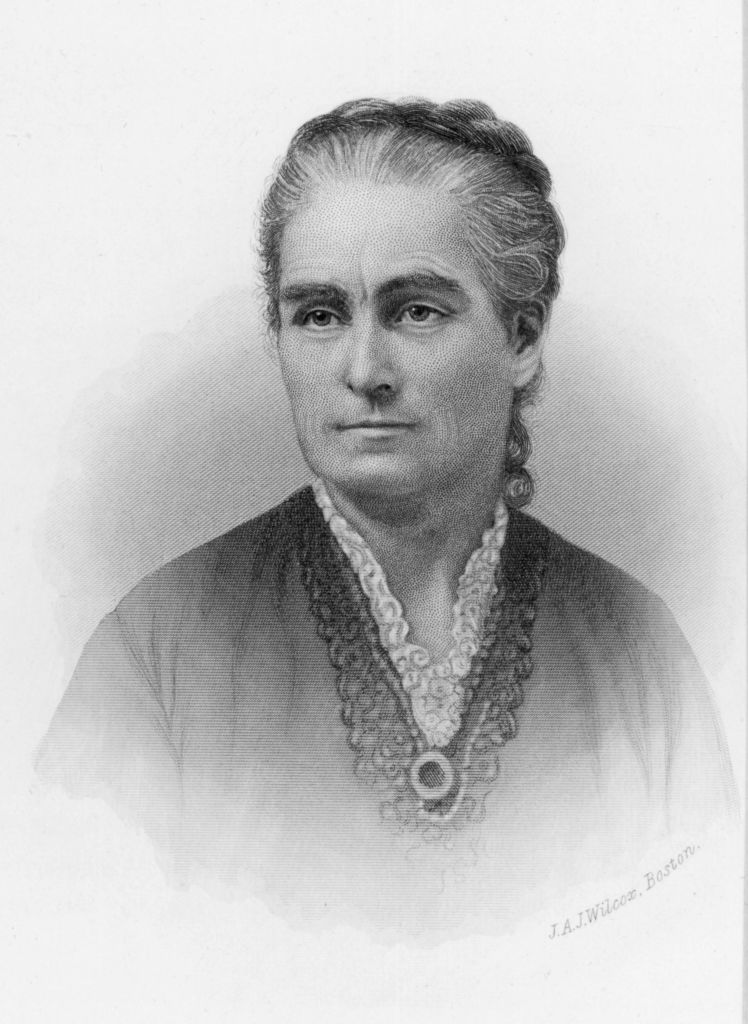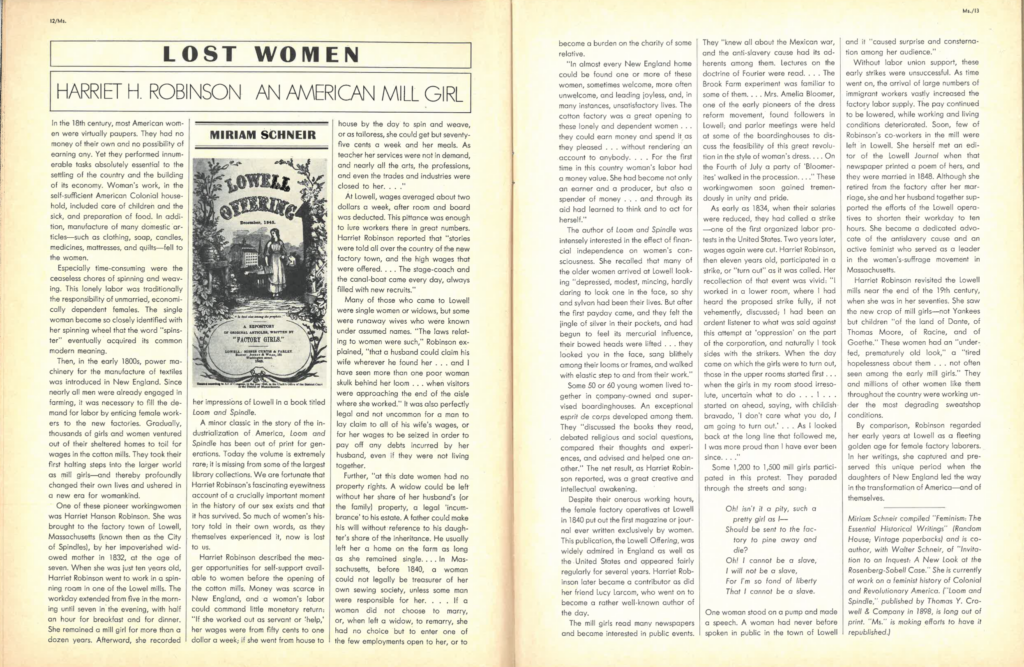Harriet Robinson captured the fleeting golden age for female factory laborers—a unique period when the daughters of New England led the way in the transformation of America … and of themselves.

Reclaiming the forgotten histories of women was the driving force behind Ms.‘ monthly column “Lost Women.” One of the column’s early writers, Gerda Lerner, declared, “Women’s history is women’s right.” The column celebrated the contributions of women across industries, many of whose stories would have been lost if not chronicled in the pages of Ms.
This Women’s History Month, we’re reviving the iconic “Lost Women” column—diving into the archives to make these histories more accessible to our new age of Ms. readers.
This story was originally published in the August 1972 issue of Ms. and has been edited for clarity.
In the 18th century, most American women were virtually paupers. They had no money of their own and no possibility of earning any. Yet they performed innumerable tasks essential to the settling of the country and the building of its economy.
Women’s work, in the self-sufficient American colonial household, included care of children and the sick, and preparation of food. The manufacture of many domestic articles––such as clothing, soap, candles, medicines, mattresses and quilts––also fell to the women.
Especially time-consuming were the ceaseless chores of spinning and weaving. This lonely labor was traditionally the responsibility of unmarried, economically dependent females. The single woman became so closely identified with her spinning wheel that the word “spinster” eventually acquired its common modern meaning.
Then, in the early 1800s, power machinery for the manufacture of textiles was introduced in New England. Since nearly all men were already engaged in farming, it was necessary to fill the demand for labor by enticing female workers to the new factories. Gradually thousands of girls and women ventured out of their sheltered homes to toil for wages in the cotton mills. They took their first halting steps into the larger world as mill girls—and thereby profoundly changed their own lives and ushered in a new era for womankind.
The single woman became so closely identified with her spinning wheel that the word ‘spinster’ eventually acquired its common modern meaning.
One of these pioneer workingwomen was Harriet Hanson Robinson. She was brought to the factory town of Lowell, Mass. (known then as “The City of Spindles”), by her impoverished widowed mother in 1832 at the age of 7.
When she was just 10 years old, Harriet Robinson went to work in a spinning room in one of the Lowell mills. The workday extended from 5 in the morning until 7 in the evening, with half an hour for breakfast and dinner. She remained a mill girl for more than a dozen years. Afterwards, she recorded her impressions of Lowell in a book titled Loom and Spindle.

A minor classic in the story of the industrialization of America, Loom and Spindle has been out of print for generations. Today the volume is extremely rare; it is missing from some of the largest library collections. We are fortunate that Harriet Robinson’s fascinating eyewitness account of a crucially important moment in the history of our sex exists and that it has survived. So much of women’s history told in their own words, as they themselves experienced it, now is lost to us.
Harriet Robinson described the meager opportunities for self-support available to women before the opening of the cotton mills. Money was scarce in New England, and a woman’s labor could command little monetary return:
“If she worked out as servant or ‘help,’ her wages were from 50 cents to one dollar a week; if she went from house to house by the day to spin and weave, or as tailoress, she could get but 75 cents a week and her meals. As teacher her services were not in demand, and nearly all the arts, the professions, and even the traders and industries were closed to her….”
At Lowell, wages averaged about 2 dollars a week, after room and board was deducted.
Many of those who came to Lowell were single women or widows, but some were runaway wives who were known under assumed names.
“The laws relating to women were such,” Robinson explained, “that a husband could claim his wife wherever he found her…” It was also perfectly legal and not uncommon for a man to lay claim to all of his wife’s wages, or for her wages to be seized in order to pay off any debts incurred by her husband, even if they were not living together.
The author of Loom and Spindle was intensely interested in the effect of financial independence on women’s consciousness. She recalled that many of the older women arrived at Lowell looking “depressed, modest, mincing, hardly daring to look one in the face, so shy and sylvan had been their lives. But after the first payday came, and they felt the jingle of silver in their pockets, and had begun to feel its mercurial influence, their bowed heads were lifted. …They looked you in the face, sang blithely among their looms or frames, and walked with elastic step to and from their work.”
Some 50 or 60 young women lived together in company-owned and supervised boardinghouses. An exceptional esprit de corps developed among them. They “discussed the books they read, debated religious and social questions, compared their thoughts and experiences, and advised and helped one another.”
The net result, as Harriet Robinson reported, was a great creative and intellectual awakening.
After the first payday came, and they felt the jingle of silver in their pockets, and had begun to feel its mercurial influence, their bowed heads were lifted.
Harriet H. Robinson

Despite their onerous working hours, the female factory operatives at Lowell in 1840 put out the first magazine or journal ever written exclusively by women. This publication, The Offering, was widely admired in England as well as the United States and appeared fairly regularly for several years. Harriet Robinson later became a contributor as did her friend Lucy Larcom, who went on to become a rather well-known author of the day.
As early as 1834, when their salaries were reduced, they had called a strike––one of the first organized labor protests in the United States.
Two years later, wages again were cut. Harriet Robinson, then 11 years old, participated in a strike, or “turn out” as it was called.
Some 1,200 to 1,500 mill girls participated in this protest. They paraded through the streets and sang:
Oh! isn’t it a pity, such a pretty girl as I ––
Should be sent to the factory to pine away and die?
Oh! I cannot be a slave,
I will not be a slave,
For I’m so fond of liberty
That I cannot be a slave.
One woman stood on a pump and made a speech. A woman had never before spoken in public in the town of Lowell and it “caused surprise and consternation among her audience.”
Without labor union support, these early strikes were unsuccessful. As time went on, the arrival of large numbers of immigrant workers vastly increased the factory labor supply. The pay continued to be lowered, while working and living conditions deteriorated.
Soon, few of Robinson’s co-workers in the mill were left in Lowell. She herself met an editor of the Lowell Journal when that newspaper printed a poem of hers, and they were married in 1848. Although she retired from the factory after her marriage, she and her husband together supported the efforts of the Lowell operatives to shorten their workday to 10 hours. She became a dedicated advocate of the anti-slavery cause and an active feminist who served as a leader in the suffrage movement in Massachusetts.
Harriet Robinson revisited the Lowell mills near the end of the 19th century, when she was in her 70s. She saw the new crop of mill girls––not Yankees but children “of the land of Dante, of Thomas Moore, of Racine, and of Goethe.” These women had an “underfed, prematurely old look,” a “tired hopelessness about them … not often seen among the early mill girls.” They and millions of other women like them throughout the country were working under the most degrading sweatshop conditions.
By comparison, Robinson regarded her early years at Lowell as a fleeting golden age for female factory laborers. In her writings, she captured and preserved this unique period when the daughters of New England led the way in the transformation of America—and of themselves.
Up next:
U.S. democracy is at a dangerous inflection point—from the demise of abortion rights, to a lack of pay equity and parental leave, to skyrocketing maternal mortality, and attacks on trans health. Left unchecked, these crises will lead to wider gaps in political participation and representation. For 50 years, Ms. has been forging feminist journalism—reporting, rebelling and truth-telling from the front-lines, championing the Equal Rights Amendment, and centering the stories of those most impacted. With all that’s at stake for equality, we are redoubling our commitment for the next 50 years. In turn, we need your help, Support Ms. today with a donation—any amount that is meaningful to you. For as little as $5 each month, you’ll receive the print magazine along with our e-newsletters, action alerts, and invitations to Ms. Studios events and podcasts. We are grateful for your loyalty and ferocity.




